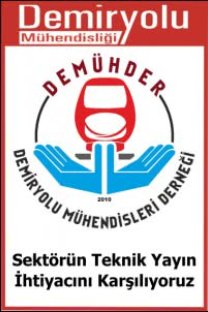Demiryollarında Arıza Durumunda Otonom Trenler için Yedek Sistem Tasarlanması
Development of Automated Fallback levels of Disrupted Railway Operations
Automated Fallback, ATO, Driverless Train Risk Analysis,
___
[1] http://www.berliner-verkehrsseiten.de/u-bahn/Stellwerke/Zugsicherungstechnik/STAR/star.html , Bakılma Tarihi 26.05.17[2] Gralla, Christoph: Sind wir bereit für den fahrerlosen Verkehr im Nah‐ und Fernverkehr? Signal + Draht, 4/2016, s. 6-16
[3] Zastrow, Kai Frederik, Dissertation - Analyse und Simulation von Entstörungsstrategien bei der Automatisierung von U-Bahnsystemen, TU Berlin, 2000, s. 2
[4] Villioth-Ebert, Heike, Richtlinie 408.21 – 27, Fahrdienstvorschrift; Deutsche Bahn AG, 2016
[5] FTA Analyse der türkischen Staatsbahn, Abteilung des Risiko- und Sicherheitsmanagement, Ankara, 2017
[6] Günther, Oliver, Ril 420.9001, Kodierung der Zusatzverspätungen, Deutsche Bahn AG, 2014
[7] Eisenbahnunfalluntersuchung, Bundesministerium für Verkehr und digitale Infrastruktur , Bonn, 2016
[8] Railway Safety Performance in the European Union, ERA (European Railway Agency), 2016
[9] Börcsök, Josef, Funktionale Sicherheit, VDE Verlag, Berlin, 2015, S.479-485
[10] Hermann Winner, Handbuch Fahrerassistenzsysteme, Vieweg + Teubner, Wiesbaden, 2012
[11] Jazdi, N., Zuverlässigkeit und Sicherheit von Automatisierungssystemen, Uni-Stuttgart, 2015
[12] BS EN 50126-1, Railway applications The specification and demonstration of Reliability, Availability, Maintainability and Safety (RAMS), British Standards, Mai 2010
[13] Braband, Jens; Brehmke, Bernd-E., et al. Die CENELEC-Normen zur Funktionalen Sicherheit, Hamburg, 2006
[14] Üyümez, Bilal, Bahnsystem und Bahntechnik, TU Darmstadt, 2017
[15] Pascoe, Robert D., What is Communication-based Train Control?, IEEE Vehicular Technology Magazine, December, 2009, s.17-21
[16] Befehle 1-14, Deutsche Bahn AG, http://www1.deutschebahn.com/file/fahrweg-de/10223642/gzU4Va4w7LuJDbVQDAQ6BKl9Hs4/10228382/data/rw_302.3000V01.pdf Bakılma Tarihi 16.06.2017
[17] http://www.stellwerke.de/signal/deutsch/sp.html, , Bakılma Tarihi 22.06.17
[18] Hörsken, Dieter; Griese, Reinhard, Ril 494.0251, Technisch Einrichtungen am Zug bedienen Selbstabfertigung durch den Tf. (SAT), DB Regio, 2001
[19] Haas, Jürgen, Rückfallebenen für Streckenausrüstung ETCS Level 2 ohne Signale, SIGNAL + DRAHT 10/2015, s. 6-10
[20] http://www.omg.org/spec/UML/2.3/Infrastructure/PDF/, , Bakılma Tarihi 14.07.17
[21] http://www.orghandbuch.de/OHB/DE/Organisationshandbuch/6_MethodenTechniken/62_Dokumentationstechniken/623_Entscheidungstabellen/entscheidungstabellen-node.html , Bakılma Tarihi 26.07.2016
[22] Lemke, Oliver, Modellbasierte Anforderungsspezifikation sicherheitskritischer Systeme im Bahnbereich – Beschreibungsmittel und ihre Anwendung, Technischen Universität Carolo-Wilhelmina, 2010
[23] http://www.schmidt-bernd.eu/philosophie/systemtheorie/kuenstliche_intelligenz/2_PECSAgent/PECSAgent.pdf , Bakılma Tarihi 10.08.17
[24] http://db-livemaps.hafas.de/bin/query.exe/dn?tpl=fullscreenmap&L=vs_baustellen&useZoomDependentPrio=false , Bakılma Tarihi 26.05.17
[25] Aparna, S.; Sujatha Priyadharshini, A., Emergency Management of Urban Rail Transportation Using CBTC System, PRIST University, Thanjavur, India, März 2015
[26] Lindner, Tobias, et al., Betrachtungen zur Zuverlässigkeit des Triebfahrzeugführers, EI-Eisenbahningenieur, Januar 2014, s. 10-16
[27] ERTMS/ETCS SUBSET-026-4, V. 3.6.0- System Requirements Specification Chapter 4 Modes and Transitions, ERA (European Railway Agency), 05/2016
[28] Lindner, Tobias, Entwicklung einer Methode zur Bewertung unterschiedlicher Rückfallebenen, SIGNAL + DRAHT, 5/2012, s. 37-39
[29] Kämmerer, Florian Rudolf, Entwicklung eines Kennzahlensystems für Effektivität des Bahnbetriebs bei Abweichungen vom Regelbetrieb, Institut für Verkehr der TU Darmstadt FB Bahnsysteme, 2017
- ISSN: 2149-1607
- Yayın Aralığı: 2
- Başlangıç: 2014
- Yayıncı: Demiryolu Mühendisleri Derneği
Hilal KUTLU, Hayri ULVİ, Furkan AKDEMİR
Uluslararası Ticarette Demiryolunun Lojistik Performansa Etkisi
Sema DİNÇ, Mustafa HAMURCU, Tamer EREN
Demiryollarında Arıza Durumunda Otonom Trenler için Yedek Sistem Tasarlanması
Elektrikli Demiryolu Hatlarında Kompanzasyon Sistemi
Ömür DOĞRUER, Şule KUŞDOĞAN, Nuran YÖRÜKEREN
Önüretimli ve Öngerilmeli Beton Traverslerde Gözlenen Zamana Bağlı Kısalmalarının Değerlendirilmesi
